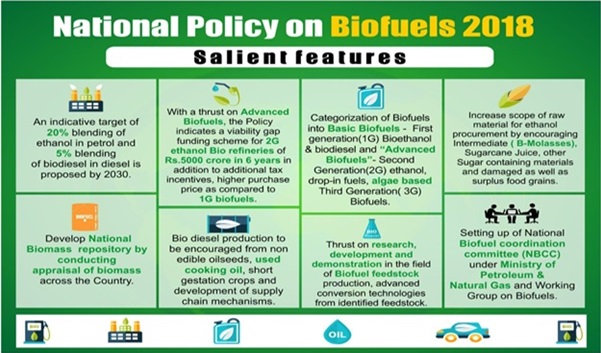India’s Ethanol Production Programme and Ethanol Blended Petro (Indian Express)

- 25 Jul 2023
Why in the News?
Prime Minister Modi, at a G20 Energy Ministers’ meet on Saturday (July 22), said that India has rolled out 20% ethanol-blended petrol this year and aims to “cover the entire country by 2025”.
What is Ethanol?
- Ethanol, also known as ethyl alcohol or grain alcohol, is basically 9% pure alcohol that can be blended with petrol.
- It is distinct from 94% rectified spirit, commonly used in paints and pharmaceuticals, as well as 96% extra neutral alcohol, which is utilized in the production of potable liquor.
- It is also a renewable biofuel and can be derived from various plant sources, such as sugarcane, corn, wheat, and other agricultural products, through the process of fermentation and distillation.
- Ethanol has a wide range of industrial, commercial, and recreational applications, making it a versatile and important chemical compound.
Ethanol blending programme (EBP) in India:
Overview:
- The Ethanol Blending Programme (EBP) in India began with pilot projects that supplied 5% ethanol-blended petrol to retail outlets.
- The successful field trials led to the official launch of the EBP in 2003.
- The program aimed to promote 5% ethanol-blended petrol in 9 States and 4 Union Territories, utilizing a separate pumping and BIO-metering mechanism.
Objectives:
- The EBP aimed at reducing the country's reliance on crude oil imports, curbing carbon emissions, and enhancing farmers' incomes.
Targets:
- Initially, India targeted 10% ethanol blending in petrol by the end of 2022 and 20% blending by 2030.
- However, in December 2020, the government accelerated its target of achieving 20% blending (E20) to 2025.
- Alsoly, there is a target of 5% blending of biodiesel with diesel by 2030.
Incentive Measures:
- To encourage blending, the government introduced an additional duty of Rs. 2 per litre on unblended fuels starting October.
Significance of Ethanol Blending:
- Energy Security: As the third-largest consumer of energy globally, India aims to enhance its energy self-dependency through ethanol blending, aligning with the AtmaNirbhar Bharat Abhiyan.
- Reducing Import Dependency: Ethanol blending in petrol will decrease India's reliance on crude oil and natural gas imports, potentially saving around USD 4 billion (Rs. 300 billion) per year.
- Support for the Agricultural Sector: The program aids sugar mill owners in paying farmers their pending Fair and Remunerative Price (FRP) for sugarcane and mitigates the impact of low sugar prices in the international market, providing additional income to farmers.
- Environmental Friendly Fuel: Ethanol-blended petrol results in smoother combustion, reducing emissions of CO, hydrocarbons, and NOx, and contributing to a more environmentally friendly fuel option.
- Decreasing Pollution: Using ethanol-blended petrol leads to lower emissions of CO, HC, and NOx, making it an effective measure to decrease pollution levels and promote cleaner air.
- SDG Targets: Ethanol blending aligns with Sustainable Development Goal targets by reducing emissions and mitigating climate change effects.
Related Issues with Ethanol Blending Programme:
- National Policy on Biofuel: The new ethanol blending target focuses on food-based feedstocks, deviating from the 2018 National Policy on Biofuels, which emphasized non-food feedstocks like grasses, algae, and cellulosic materials.
- This change raises concerns about grain surpluses and the impact on food availability.
- Risk of Hunger: The diversion of food grains to distilleries at cheaper prices could affect food security for the impoverished, potentially leading to increased hunger risks.
- India ranks 101st out of 116 countries on the World Hunger Index 2021.
- Cost Implications: The production of biofuels requires land, impacting the cost of biofuels as well as food crops, which can have economic implications.
- Water Usage: Biofuel crops and the manufacturing process require significant amounts of water, which can strain local and regional water resources.
- Efficiency Comparison: Some biofuels produce less energy compared to fossil fuels.
- For instance, 1 gallon of ethanol generates less energy than 1 gallon of gasoline, raising concerns about the efficiency of biofuels as a viable alternative.
Addressing these issues is crucial for implementing ethanol blending targets in a sustainable and responsible manner.
Ethanol Program: Benefits and Concerns:
Benefits:
- The ethanol program offers several advantages, including reduced dependence on fossil fuels, promotion of sustainable practices, and new opportunities for farmers and industries. Advancements like multi-effect evaporator units have enabled the utilization of distilleries' liquid effluent for boiler fuel and the production of fertilizer and animal feed as by-products.
Concerns:
- Despite its benefits, the ethanol program raises some concerns. Increased demand for grains in ethanol production may impact food supply and prices. Additionally, distilleries' liquid effluent can pose environmental challenges.
The ethanol program shows great promise in achieving sustainable goals while addressing environmental and economic challenges. With proper management and technological advancements, it can play a vital role in India's energy and agricultural sectors.
Mains Question:
- Discuss the benefits, concerns, and significance of India's ethanol program, focusing on reducing fossil fuel dependence, promoting sustainability, and addressing the impact on food supply and prices. (15 M)
